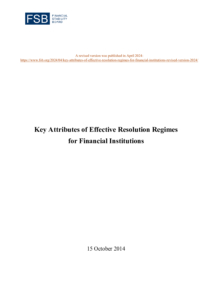Basel +41 76 350 8684
The Financial Stability Board (FSB) has today reissued the Key Attributes of Effective Resolution Regimes for Financial Institutions (‘the Key Attributes’) incorporating guidance on their application to non-bank financial institutions and on arrangements for information sharing that support the effective resolution of cross-border financial institutions. Four new Annexes to the Key Attributes set out guidance covering:
- Resolution of Financial Market Infrastructures (FMIs), including central counterparties (CCPs), and resolution of systemically important FMI participants;
- Resolution of insurers;
- Client asset protection in resolution; and
- Information sharing for resolution purposes.
The Annexes have been developed by the FSB in conjunction with relevant standard-setting bodies (Committee on Payment and Market Infrastructure (CPMI), International Association of Insurance Supervisors (IAIS) and International Organization of Securities Commissions (IOSCO). They were issued for public consultation in August 2013 and have been revised in light of the comments received.
The Annex on FMI resolution together with the report on FMI recovery published today by CPMI and IOSCO provide a comprehensive set of guidance on recovery and resolution for different kinds of systemically important FMI.
The Annex on resolution of insurers elaborates in further detail on the resolution framework for systemically important insurers and should assist authorities and firms in implementing the resolution planning requirements set out in the policy measures for global systemically important insurers (G-SIIs) published by the IAIS in July 2013.
The Annex on client asset protection in resolution builds on IOSCO’s Report on Recommendations Regarding the Protection of Client Assets of January 2014.
The Annex on information sharing for resolution purposes sets out principles for the design of national legal gateways and confidentiality regimes to allow the exchange with domestic and foreign authorities of non-public information that is necessary for planning and carrying out resolution. It also includes provisions on information sharing and confidentiality that should be included in the institution-specific cross-border cooperation agreements (COAGs) that the Key Attributes require for all global systemically important financial institutions (G-SIFIs).
Mark Carney, Chair of the FSB, said: “The guidance published today is another significant step to giving authorities the tools to manage the failure of any type of systemic institution. The development of resolution regimes for non-bank financial institutions will complement the progress made in enabling the resolution of banks. With the introduction of mandatory central clearing of OTC derivatives, it is crucial that we avoid the threat of CCPs becoming the new “too big to fail” institutions.”
Elke König, Chair of the FSB’s Resolution Steering Group, noted: “This guidance will give impetus to the adoption by countries around the world of appropriate tools to deal with the failure of FMIs, insurers and firms holding client assets and assist authorities in preparing resolution plans for all such firms that could be systemic in the event of failure.”
Notes to editors
The Key Attributes of Effective Resolution Regimes for Financial Institutions are the international standard for resolution regimes for financial institutions. They are a key component of the FSB’s policy framework to address the moral hazard and systemic risks associated with institution that are “too big to fail”. They were released by the FSB in November 2011 following their endorsement by G20 Leaders at the Cannes Summit. When the FSB adopted the Key Attributes in 2011 it was agreed to develop further guidance on the implementation of the Key Attributes, taking into account the need for implementation to accommodate sector-specific considerations.
The FSB’s report to the G20 on Progress and Next Steps Towards \”Ending Too Big To Fail\” (TBTF Report) of September 2013 set out the further actions required from the G20, the FSB and other international bodies to complete the policy initiative to end “too-big-to-fail”. It noted the need for the FSB, working in conjunction with standard-setting bodies, to finalise guidance on how the Key Attributes should be interpreted and implemented with respect to the resolution of FMIs, the resolution of insurers and the protection of client assets in resolution. It also identified the lack of ability for authorities to share information for resolution purpose as an obstacle to cross-border resolution. The newly adopted guidance documents have been incorporated as annexes into the 2014 version of the Key Attributes document. No changes were made to the text of the twelve Key Attributes of October 2011. The twelve Key Attributes remain the umbrella standard for resolution regimes covering financial institutions of all types that could be systemic in failure.
The FSB Resolution Steering Group leads the FSB’s work on resolution and resolution planning and developed the Key Attributes. The Annexes were developed with input from the Committee on Payment and Market Infrastructure (CPMI), International Association of Insurance Supervisors (IAIS) and the International Organization of Securities Commissions (IOSCO).
The FSB was established to coordinate at the international level the work of national financial authorities and international standard setting bodies and to develop and promote the implementation of effective regulatory, supervisory and other financial sector policies in the interest of financial stability. It brings together national authorities responsible for financial stability in 24 countries and jurisdictions, international financial institutions, sector-specific international groupings of regulators and supervisors, and committees of central bank experts. The FSB also conducts outreach with 65 other jurisdictions through its six regional consultative groups.
The FSB is chaired by Mark Carney, Governor of the Bank of England. Its Secretariat is located in Basel, Switzerland, and hosted by the Bank for International Settlements.
